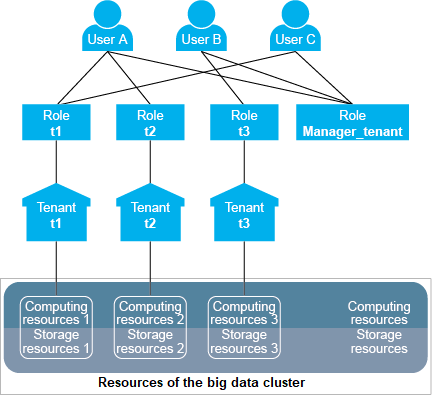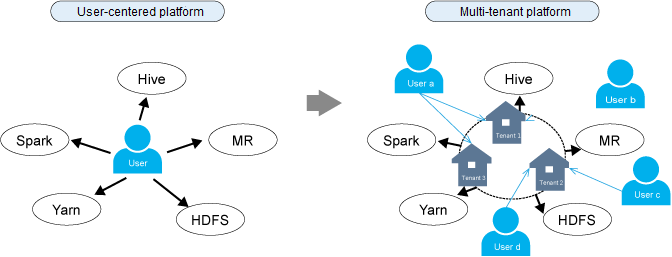Multi-Tenant Model
Related Model
The following figure shows a multi-tenant model.
Table 1 describes the concepts involved in Figure 1.
Concept |
Description |
|---|---|
User |
A natural person who has a username and password and uses the big data cluster. There are three different users in Figure 1: user A, user B, and user C. |
Role |
A role is a carrier of one or more permissions. Permissions are assigned to specific objects, for example, access permissions for the /tenant directory in HDFS. Figure 1 shows four roles: t1, t2, t3, and Manager_tenant.
|
Tenant |
A tenant is a resource set in a big data cluster. Multiple tenants are referred to as multi-tenancy. The resource sets further divided under a tenant are called sub-tenants. Figure 1 shows three tenants: t1, t2, and t3. |
Resource |
|
If a user wants to use a tenant's resources or add or delete a sub-tenant of a tenant, the user needs to be bound to both the tenant role and role Manager_tenant. Table 2 lists the roles bound to each user in Figure 1.
User |
Role |
Permission |
|---|---|---|
User A |
|
|
User B |
|
|
User C |
|
|
A user can be bound to multiple roles, and one role can also be bound to multiple users. Users are associated with tenants after being bound to the tenant roles. Therefore, tenants and users form a many-to-many relationship. One user can use the resources of multiple tenants, and multiple users can use the resources of the same tenant. For example, in Figure 1, user A uses the resources of tenants t1 and t2, and users A and C uses the resources of tenant t1.

The concepts of a parent tenant, sub-tenant, level-1 tenant, and level-2 tenant are all designed for the multi-tenant service scenarios. Pay attention to the differences these concepts and the concepts of a leaf tenant resource and non-leaf tenant resource on FusionInsight Manager.
- Level-1 tenant: determined based on the tenant's level. For example, the first created tenant is a level-1 tenant and its sub-tenant is a level-2 tenant.
- Parent tenant and sub-tenant: indicates the hierarchical relationship between tenants.
- Non-leaf tenant resource: indicates the tenant type selected during tenant creation. This tenant type can be used to create sub-tenants.
- Leaf tenant resource: indicates the tenant type selected during tenant creation. This tenant type cannot be used to create sub-tenants.
Multi-Tenant Platform
Tenant is a core concept of the FusionInsight big data platform. It plays an important role in big data platforms' transformation from user-centered to multi-tenant to keep up with enterprises' multi-tenant application environments. Figure 2 shows the transformation of big data platforms.
On a user-centered big data platform, users can directly access and use all resources and services.
- However, user applications may use only partial cluster resources, resulting in low resource utilization.
- The data of different users may be stored together, decreasing data security.
On a multi-tenant big data platform, users use required resources and services by accessing the tenants.
- Resources are allocated and scheduled based on application requirements and used based on tenants, increasing resource utilization.
- Users can access the resources of tenants only after being associated with tenant roles, enhancing access security.
- The data of tenants is isolated, ensuring data security.
Feedback
Was this page helpful?
Provide feedbackThank you very much for your feedback. We will continue working to improve the documentation.See the reply and handling status in My Cloud VOC.
For any further questions, feel free to contact us through the chatbot.
Chatbot










